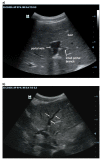Point-of-care ultrasound to inform antiviral treatment initiation in chronic hepatitis B virus infection in low-resource settings - the PUSH protocol
- PMID: 38436778
- PMCID: PMC10912069
- DOI: 10.1186/s13089-024-00369-2
Point-of-care ultrasound to inform antiviral treatment initiation in chronic hepatitis B virus infection in low-resource settings - the PUSH protocol
Abstract
Background: Chronic Hepatitis B (CHB) is prevalent worldwide and most related deaths occur in low-resource settings. Antiviral treatment of CHB is indicated in those with significant liver disease and markers of viral replication. However, recommended diagnostics such as elastography (a non-invasive imaging measure of fibrosis/cirrhosis) or HBV viral load are often lacking in these settings, which creates barriers to treatment. Point-of-care clinical B-mode ultrasound (US) has potential to overcome implementation barriers in HBV care programs in low-resource settings.
Methods: We describe a Point-of-care US protocol for Hepatitis ("PUSH") to check for signs of cirrhosis and hepatocellular carcinoma in the liver of people with CHB. We performed a prospective observational study applying the protocol, first by trainee clinicians and then by trainers, in consecutive patients referred to our clinic for CHB treatment eligibility assessment. All patients additionally underwent physical examination, liver function tests (LFTs) and platelet counts. We describe the PUSH training approach and performance of the protocol.
Results: Four clinicians and 111 adult patients with HBV infection were included in the development of PUSH. Using US, liver complications of HBV were documented in 31 (27.9%) patients; including cirrhosis in 15 patients, HCC with cirrhosis in 13, and HCC without cirrhosis in 3. Patients with sonographic findings had significantly more clinical symptoms also their LFTs were higher and more frequently indicative for HBV treatment. Of 28 patients with sonographic diagnosis of cirrhosis, 23 (82.1%) showed a nodular liver surface, 24 (85.7%) a coarse echotexture, 20 (71.4%) scarce vessels, and 9 (32.1%) an enlarged caudate lobe. Overall concordance of the findings between assessment of trainees and experienced sonographers was high, ranging from 90 to 95%; trainees were not blinded to clinical and laboratory findings.
Conclusion: Ultrasound can facilitate same-day initiation of antiviral therapy for chronic HBV monoinfection in a resource-limited setting and a streamlined protocol-driven liver ultrasound can be feasibly used by front line clinicians managing HBV.
Keywords: Cirrhosis; HCC; Hepatitis B; Low-resource setting; Treatment indication; Ultrasound.
© 2024. The Author(s).
Conflict of interest statement
The authors declare that they have no competing interests.
Figures






Similar articles
-
Liver histopathological lesions is severe in patients with normal alanine transaminase and low to moderate hepatitis B virus DNA replication.World J Gastroenterol. 2023 Apr 28;29(16):2479-2494. doi: 10.3748/wjg.v29.i16.2479. World J Gastroenterol. 2023. PMID: 37179582 Free PMC article.
-
Gaps and Disparities in Chronic Hepatitis B Monitoring and Treatment in the United States, 2016-2019.Med Care. 2023 Apr 1;61(4):247-253. doi: 10.1097/MLR.0000000000001825. Epub 2023 Feb 3. Med Care. 2023. PMID: 36893410 Free PMC article.
-
Non-linear association of baseline viral load with on-treatment hepatocellular carcinoma risk in chronic hepatitis B.Gut. 2024 Mar 7;73(4):649-658. doi: 10.1136/gutjnl-2023-330225. Gut. 2024. PMID: 37813567
-
Risk for hepatocellular carcinoma in the course of chronic hepatitis B virus infection and the protective effect of therapy with nucleos(t)ide analogues.World J Hepatol. 2015 May 18;7(8):1064-73. doi: 10.4254/wjh.v7.i8.1064. World J Hepatol. 2015. PMID: 26052395 Free PMC article. Review.
-
Treatment of chronic hepatitis B: case selection and duration of therapy.J Gastroenterol Hepatol. 2002 Apr;17(4):409-14. doi: 10.1046/j.1440-1746.2002.02767.x. J Gastroenterol Hepatol. 2002. PMID: 11982721 Review.
Cited by
-
Predicting clinical outcomes in chronic hepatitis B patients receiving nucleoside analogues and pegylated interferon alpha: a hematochemical and clinical analysis.BMC Infect Dis. 2024 Oct 13;24(1):1149. doi: 10.1186/s12879-024-10057-0. BMC Infect Dis. 2024. PMID: 39396949 Free PMC article.
References
Grants and funding
LinkOut - more resources
Full Text Sources
